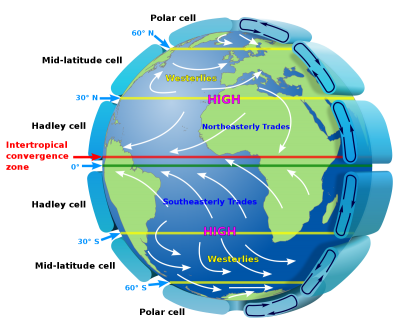
|
It is the uniform pattern in which air moves around our planet’s atmosphere. It happens because the Sun heats Earth more at the equator than at the poles, and it is also affected by the spinning of the Earth. |
Solar radiation that reaches the Earth passes through the atmosphere and is either absorbed or reflected by the atmosphere and Earth’s surface. Most of this absorption happens on Earth’s surfaces, which increases the temperature of both land and water. A small amount of heat in the first few centimeters of the atmosphere is transferred from the surface by conduction, the process of molecules colliding and transferring energy. Because air molecules are farther apart than they are in liquids or solids, they do not collide as frequently as in liquids and solids, and air is a poor conductor of heat. Most heat is transferred in the atmosphere by radiation and convection.
Sunlight absorbed by Earth’s surfaces is re-radiated as heat, warming the atmosphere from the bottom up. This heat is absorbed and re-radiated by greenhouse gases in the atmosphere, resulting in the greenhouse effect. Warmed air expands and becomes less dense than cool air, so warmed air near the surface of the Earth rises up. Cooler air from above sinks and air moves horizontally to replace the rising warm air, which we experience as wind over the surface of the Earth. This transfer of heat because of density differences in air is called convection.
Patterns of air movement are further complicated because of Earth’s spin. Air moving from the equator towards the poles does not travel in a straight line, but is deflected because of the Coriolis effect, adding to the complexity of atmospheric circulation patterns.
Credit: Understanding Global change
Picture Credit : Google




